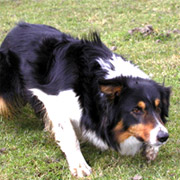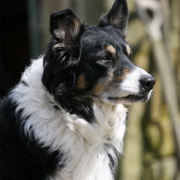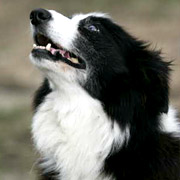‘There is no good flock without a good shepherd. And no good shepherd without a good dog’ So goes the old saying and it is true that the history of the Border Collie is totally bound up with the species they were developed to work – sheep.

Understanding the breed helps in training and management but with that knowledge must come an understanding of the breed’s ancestry and of the commitment of the shepherds who cared enough to breed only the best. For without them and their knowledge the Border Collie as we know it today would not exist.
On the History of the Breed link you will find a fascinating account of how our ancestors gave us not just a breed but a legacy that is worth every effort needed to secure the future of the Border Collie.
Ancient herding dogs
The Neolithic Revolution moved civilisation out of the Middle Stone Age into the New Stone Age around 9000 to 7000BC with the earliest evidence in South West Asia where people lived in settled villages, cultivating grains and domesticating animals including early sheep. Gradually domesticated animals spread north into what is now Europe and archaeological digs in the UK have recovered sheep bones and woollen fragments.

Remains of dogs have been found in Neolithic settlements near Avebury in Wiltshire not far from the great stone circle of Stonehenge. In these wild days, dogs’ early involvement with sheep would have been as guard dogs and they would have been savage, half wild animals capable of tackling large predators such as wolves and lynx.
For hundreds of years, sheep were prized not for their meat but for their wool. English nobles made fortunes turning peasants off their lands, converting them to sheep pastures and exporting the wool to the continent where the skilled craftsmen in Flanders turned English wool into the finest quality cloth. So valuable was this product that English kings saw an opportunity to make money and insisted that wool was exported through a few named ports so that royal officials could count the bails and levy and export tax. By the eighteenth century, religious persecution of the Protestant Huguenots in Flanders drove them from their homes and many settled in England bringing with them their cloth making skills.
The Shepherd’s dog
With the slaughter of the last wolf in Britain sometime around the late 1600’s – mid 1700’s (stories vary a lot) came the need for a different kind of dog and there is evidence that the right kind was already in existence.

One of the earliest references to dogs working sheep comes in De Canibus Britannicus, written by a Dr Johannes Cauis of Cambridge University and translated from the Latin original around 1570 in which he refers to the driving of sheep by dogs who worked off their master’s voice and whistle.
In 1790 came a book published by Thomas Bewick, a Northumbrian engraver, entitled General History of Quadrupeds and including a drawing of a black and white shepherd’s dog and a description of its way of working which is very similar to a modern Border Collie. Bewick also said that these dogs ‘appear to be preserved in greatest purity in the Northern parts of England and Scotland’ and that ‘the shepherd’s dogs are called colley dogs’. This bears out the view that ‘collie’ comes from ‘col’, the Anglo Saxon word for black and probably refers not only to the dogs but to the sheep which at that time in Scotland were mostly black. ‘Border’ from the fact that the dogs were developed in the borders between England and Scotland.
An historical article published in International Sheepdog News and covering the history of dogs exported to Australia, recorded a report of two dogs purchased in New South Wales in 1878. Tweed is described as ‘pure bred Perthshire colley. Blue or granite grey colour, most esteemed in the Highlands and of a rare strain’. Fantail was a ‘pure bred colley bitch……black and tan of a very rare sort….descended from the Woburn Park breed introduced by John, the Farmer Duke of Bedford, fifty years ago and kept quite pure since.’
The Border Collie

So now we come to the recorded history of the modern Border Collie. At the end of the 1800’s a dog called Old Hemp was born and set his stamp on all the Border Collies that came after him. His breeder, Adam Telfer, said of the dog that ‘he flashed like a meteor across the sheepdog horizon. There was never such an outstanding personality’. But of course, there was another 70 odd years to come before the legend that was Wiston Cap was born.
The life of shepherds and their dogs before World War One was one of unremitting hard labour. Shepherds and their dogs worked long hours in all weathers but a day off was not for rest but an opportunity to meet other local shepherds and show off their dogs at sheepdog trials, even if it meant walking to and from a trial and sleeping rough if the trial was a long way away.
The first official trial was organised in Bala, North Wales in 1973 by a Mr Lloyd Price. The winner was a Scottish shepherd, James Thomson with his dog, Tweed, then working in Wales. In 1906 the International Sheepdog Society (ISDS) was started by Scottish sheepdog enthusiasts and although ‘International’ was part of its name from the start, early members were mostly Scottish and early Society trials were all held in Scotland, The Society held the first International Trial in 1906 but recognised the trial of 1873 by taking the 1973 International back to Bala, and held on the same estate still owned by the Lloyd Price family. It was at this trial that the very first trophy, won in 1873, was displayed and from 1984 it was presented to the Supreme Champion. Gradually over the years, National Trials were added for England, Wales and Northern Ireland. The top dogs from all four countries, running either as individuals or as team members compete in the International Trial. As well as running trials, the ISDS set up a stud book to register every pure bred working Border Collie which continues to this day. Due to his impact on the breed, Old Hemp was posthumously accorded an ISDS number as Old Hemp 9 and so appears on the all the records of the National and International winners from 1906.
There have been many great trials champions over the years but mention must be made to one very special dog. The great Wiston Cap, the logo of the ISDS since 1973, was the most popular and used stud dog in the history of the breed. And for good reason. Winner of the 1965 Supreme Championship when under two years of age, he sired three Supreme Champions and was grand-sire to three others. He was the result of very clever and careful line breeding of blood lines all traced back to the early registered dogs of the stud book. By the time he was six months old he was working sheep and he won his first trial prize at ten months old. His owner, John Richardson, referred to him as a tremendous herding dog, equally impressive in yarding sheep as on the open hill. He had a great temperament, was always consistent and the secret of his trials success was put down to the implicit faith and communication that he and his master had with one another.
All over the world where there are flocks of sheep, there are Border Collies to work them, and each one is descended from those early colley dogs. Their worth, loyalty and sheer brilliance has stood the test of time. In the words of James Hogg, the Ettrick Shepherd, who lived in Scotland between 1780 and 1835 :
‘A single shepherd and his dog will accomplish more in gathering a stock of sheep from a highland farm than twenty shepherds could without dogs, and it is a fact that without this docile animal the pastoral life would be blank. Without the shepherd’s dog, the whole of the mountainous land in Scotland would not be worth sixpence. It would require more hands to manage a stock of sheep and drive them to market than the profits of a whole stock would be capable of maintaining’.
